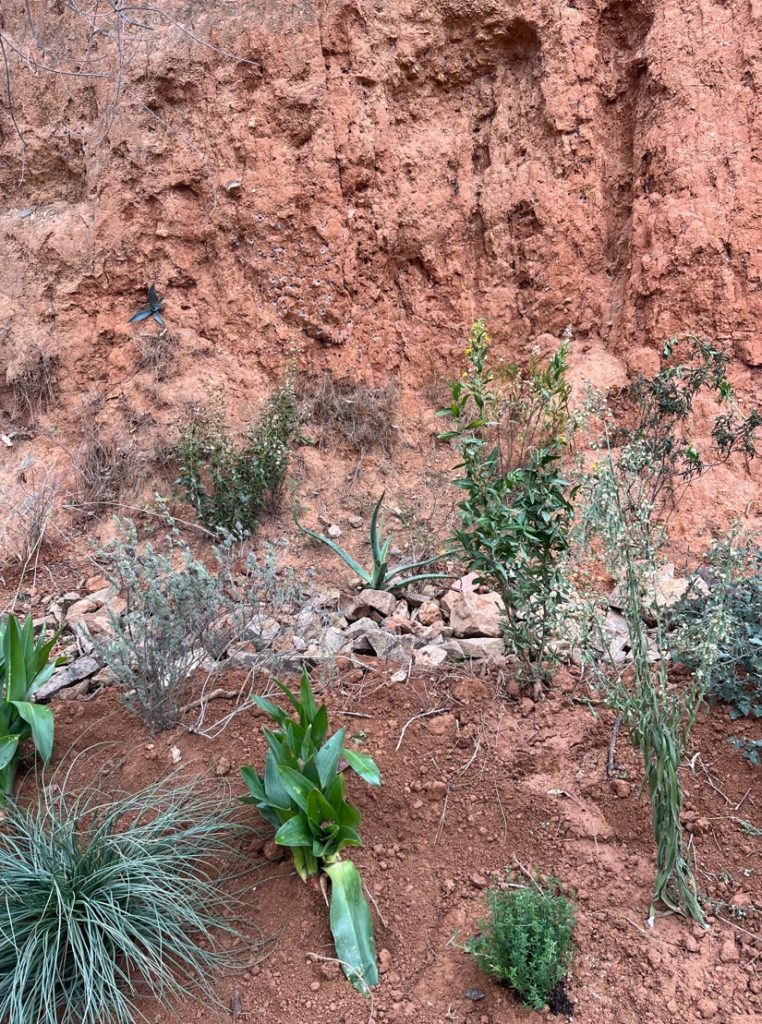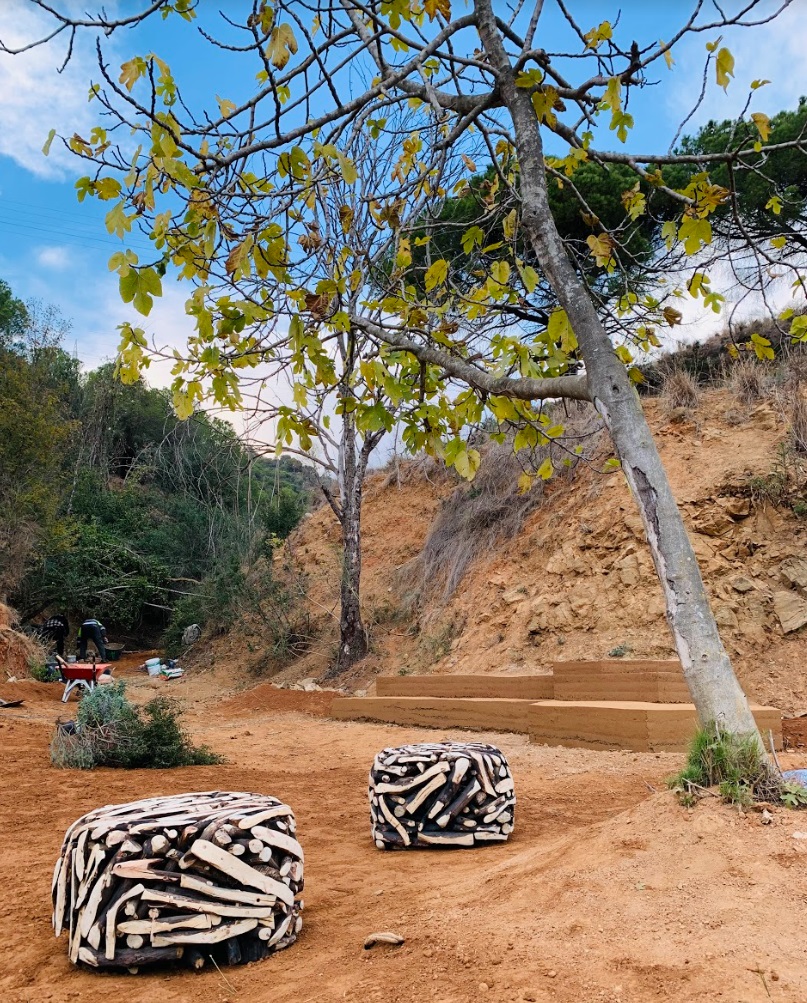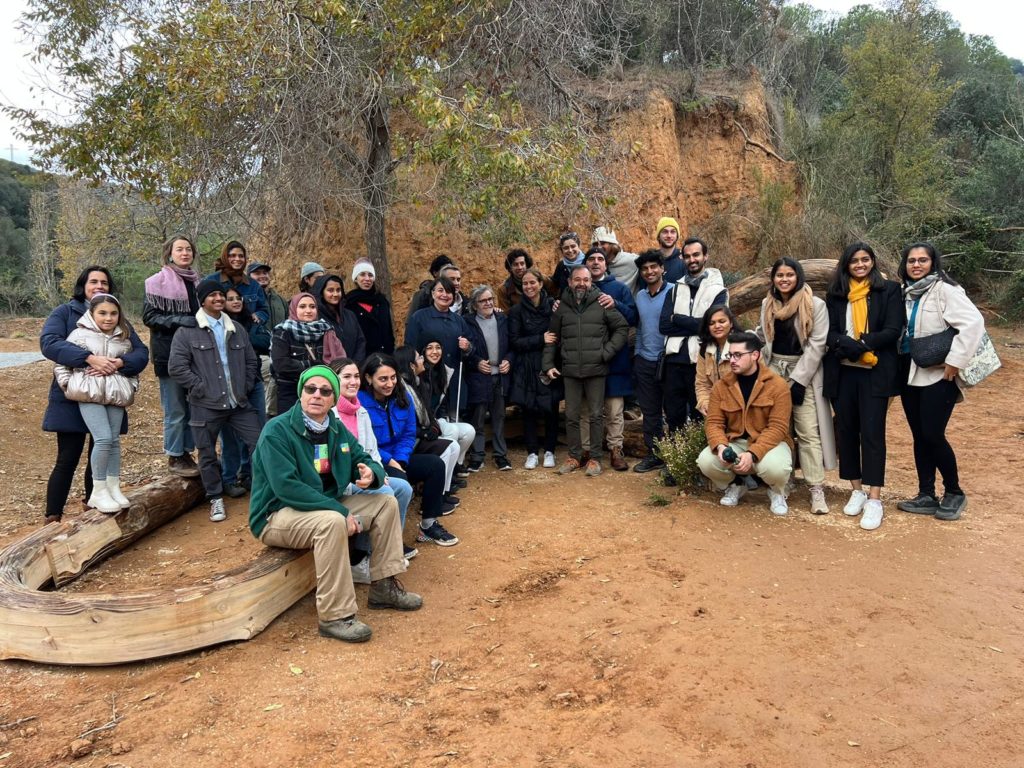
Public spaces in the city of Barcelona play a vital role in the daily lives of its citizens. But often there is a clear boundary seen between the urban and the peri-urban forests of the city. The project approaches the site of Font Del Gos as a transitory space between the city of Barcelona and the regional park of Collserola, a space that breaks the disparity and allows for an organic transition from city to nature.
As IAAC’s Valldaura Labs and Master in Advanced Ecological Buildings & Biocities (MAEBB) class of 2022/23, we have designed, produced and installed six interventions specifically honouring the site of Font del Gos, where an infamous, almost mythical fountain existed. Each intervention tackles a different issue and addresses the objective with a unique solution. However, each project and intervention is unified with one common goal, to revitalize the site with community involvement and interaction and in doing so only use natural materials and techniques that do not harm the site or the ecology that exists.
The project begins with the restoration of the dilapidated fountain which is designed using materials from the site like stone and wood held together with lime as a natural mortar. The next project is the Tapial Topography which uses rammed earth to highlight and enhance the existing landscape and in doing so acts as a retaining wall for the erosion along the hill. Juxtaposing the structural design of the rammed earth is the fluid and organic design of the Woodle, a wooden bench made from bent wood designed to create interactions and vistas. Complementing the Woodle are the Sculptural Benches placed to create interactions under the tree showing the texture and the beauty of wood. And lastly, tying the entire design together are the interventions to create the earth berms and facilitate natural vegetation and greenery.

DESIGN PROCESS
To further our design inspiration, we reached out to three different student groups from local schools and held a drawing workshop to generate ideas of what this place could become. Through our collective brainstorming, we were able to come up with some creative solutions to bring new life to the area. The design proposals were also further discussed with the community and the local authorities to bring in public involvement and understand the user’s point of view.
With our increased presence at the site, we saw an opportunity to integrate the existing streambed and watershed of the small valley with the former fountain area. This was our chance to combine the human-made environment (the city) with natural processes (nature) – a key theme of the New European Bauhaus. Additionally, we worked with the erosion control team to improve the filtration of groundwater into the clay-dominant soil. This would give plants and species a better chance of inhabiting the area and enhance biodiversity.

FOUNTAIN RESTORATION
On our initial site walks, we were inspired by the beauty of the land. There were a few existing trees, and a small valley leading uphill where a previous ‘fountain’ was once located. After conducting more research, we discovered this spot had formerly been a source of water from a natural spring, much like the many others found in Collserola Park.
The final design incorporates two large pedestal rocks and a wooden spout carved from offcuts of a local fig tree, inspired by Japanese fountain designs. To complete the terrace, we used flat large stones to complement the water flow. Finally, we mixed together lime and water to create a mortar/grout which hardened after 24 hours. This project will become a place for hikers to reflect and observe the connection between the local watershed and the city streets.
Our project will serve as a reminder of the importance of connecting nature and the city, and how nature can be a source of relaxation and contemplation. We hope that this project will inspire others to think critically about the environment and to further appreciate the beauty of the natural world.

TAPIAL TOPOGRAPHY
The site with its historical and close proximity to the forest had to be addressed with utmost sensitivity and respect. As a group, we initiated the question, how can a traditional and ancient technique be transformed and challenged through advanced digital fabrication techniques? This led to the decision to make a rammed earth structure, a structure that blended seamlessly into the existing landscape and over the span of the next few years could disintegrate back into the ground, leaving the land untouched and unharmed.
We concluded with an asymmetric and geometric fractal design using hexagons as our leading shape to create a shape that responded and adapted itself to the existing landscape. The hexagon pattern mirrors the hill and is complexified in every one of the three levels of the landscape bench, concluding in three different scales of hexagons in our design varying between 60, 90 and 120 cm in length.
We’ve concluded with Tapial Topography as a project that makes a thoughtful architectural intervention and activation of the Font del Gos site in Collserola, giving all neighbours and forest walkers a warm welcome to the park and a place to be in the community once again.

EROSION CONTROL
After analyzing the site of Font del Gos we quickly realized that soil erosion was a significant problem. The site is a case study of human interception of an ecosystem, a naturally evolved landscape and water stream disturbed by human doings, causing dysfunction.
A great benefit of an effort/ project like this is the ability to use only the resources provided by the site, leaving nothing to waste. Nature is its greatest resource. All the organic matter collected during the site’s clean-up, including whole dead trees, branches, stones, and soil, was used to create the bio berms and the swales.
In addition to their environmental benefits, bio berms can provide several social and economic benefits. By intercepting and managing runoff water, bio berms can help reduce erosion, sedimentation, and flooding, which can negatively impact nearby communities and infrastructure. They can also provide opportunities for community involvement and education and serve as a source of recreation and green space for local residents.

MIL RAMAS
The main aim of the sculpture seats was to use discarded branches and every part of the tree to create our structure in a sustainable manner. Our project’s objectives were to serve something unique, comfortable and most importantly an advanced form of seating using wooden elements. We began with collecting branches from trees that were chopped down, so not only do we use the logs for our main core structure, but we also used the branches to create the envelope around it.
Creating a space of comfortable seating, while allowing the mind to wander about the possibility of such a creation, fulfils our requirement as a group. The user should want to not only experience the seat, but also want to understand the mechanism behind it. The envelope responded to that exact demand.
Creating an aesthetic piece that fits in well with nature and have a decisive impact as a standalone structure was challenging, however, after dutiful work, it was achievable and appreciated.

WOODLE
The project ‘[Wood]le’ – a ‘Wooden Noodle’ explores the idea of steam-bending tree logs to create a self-stable structure. The Woodle assumes the function of a seating area as it rests on the ground at one end and folds up to become an element that frames the valley of Font Del Gos on the other.
The project was developed over a period of a month through iterative cycles of material prototyping and digital modelling & scripting to define and redefine workflow. The infinite loop consists of 6 members; 5 bent and 1 straight. All the logs were pine wood sourced from the Wood Yard at Valldaura.
The logs were sliced into ‘lamellae’ of different lengths on both ends, steamed and bent on an adjustable jig with a radius range of 50 – 120 cm. After the bending process, the logs were 3D scanned in order to compare the projected bending radii with the actual bending radii and get as close to the desired design as possible.
Knowing that the bent logs always have a spring back angle, the project’s salient feature is to connect the logs as an infinite loop which stabilizes and maintains the tension in the bends. The biggest challenge was to manage the forces at the connections. Due to an unforeseen degree of friction between the lamellae at the shorter ends, the intended finger joint tested at the 1:10 scale had to be replaced by a pocket joint at the 1:1 scale. In lieu of the tight timeline and limited tools, this project was concluded with the future scope of testing and devising a way to make the finger joint of the lamellae work.

The Master in Advanced Ecological Buildings and Biocities (MAEBB) is an immersive academic program of the Institute for Advanced Architecture of Catalonia (IAAC) with an emphasis on using an applied practice approach to train professionals with advanced expertise in the design and construction of ecological buildings and biocities. The MAEBB is hosted at Valldaura Labs, a facility dedicated to the investigation of self-sufficiency located in Barcelona’s Collserola Natural Park.
Open Nature was completed as a design + build studio within the 2022/23 MAEBB curriculum. The course was led by Michael Salka, Co-Director of the MAEBB; and Vicente Guallart, Co-Director of the MAEBB and Founder of IAAC. Bruno Ganem, Manager of the Green Fab Lab at Valldaura Labs; Esin Aydemir, MAEBB Academic Coordinator; and Laia Pifarré, Operations Manager at Valldaura Labs, lent their support.
The 2022/23 international MAEBB student body includes Aishwarya Balsekar, Austin Brown, Basant Abdelrahman, Carla Alvear Arizaga, Indraneel Joshi, Jackie Williams, Julia Guzman Conde, Laila Nabulsi, Larsen Bidstrup, Mariano Rodriguez Alonso, Nicolas Rotta, Nishant Maheshwaran, Pradyumna Vikharankar, Prati Jain, Ruhani Adlakha, Rujuta Chauhan, Sadegh (Ata) Raoufi Fard, Santwana Malakar, Shruti Sahasrabudhe, Sneham Pandey.


